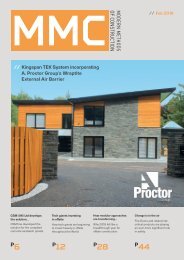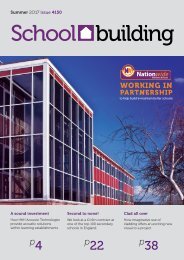You also want an ePaper? Increase the reach of your titles
YUMPU automatically turns print PDFs into web optimized ePapers that Google loves.
News<br />
Public awareness on CO safety is still inadequate<br />
Recently released figures by the CO Be Alarmed c<strong>amp</strong>aign (co-bealarmed.co.uk) show that almost a third of renters in the UK do not have a<br />
potentially life-saving carbon monoxide (CO) alarm in their property. Adrian Keats from Honeywell’s Home Safety business is reminding installers<br />
of the importance of these devices, and says that advising the public on CO safety is paramount.<br />
“CO safety is now more relevant than ever, with around 50 people dying from CO poisoning every year, and more than 200 being admitted to<br />
hospital,” he said. “But installers can take a lead role in reversing this trend by alerting homeowners, landlords and tenants of the dangers,<br />
following best practice for siting and providing the appropriate level of protection. In this way, CO-related injuries and deaths can easily be<br />
avoided.<br />
“Under current regulations, landlords in England and Wales are only required to provide a CO alarm in properties with a solid fuel appliance.<br />
However, more than 80% of homes contain a gas appliance, meaning a large number of renters could be endangered by inefficient combustion<br />
processes that produce CO contamination. What’s more, the danger may not be so evident, as CO is a silent killer.<br />
“For complete protection, a CO alarm should be placed in every room which contains a fuel burning appliance, as well as an alarm in any<br />
bedroom in the building.”<br />
UK launch for water leak detection<br />
Central Alliance has entered into a strategic partnership with<br />
specialist satellite imaging analysis organisation ULTILIS Corp. to<br />
bring a revolutionary new method of analysing saturated ground<br />
and detecting water leaks to the UK.<br />
The technology enables organisations to map ground saturation<br />
and water leaks remotely from space using innovative satellite<br />
imaging analysis. The innovative, cutting-edge technology can also<br />
be used to highlight drainage issues across areas of land, as well as<br />
spot areas that could be prone to earthworks or structure failures.<br />
Presented in the form of a ‘heat map,’ data analysis can also help<br />
understand the potential impacts of leaking water pipes and their<br />
interaction with critical infrastructure and identify ‘at-risk’ locations,<br />
where structures or earthworks could be prone to failure.<br />
Berry Piling secures Camden Lock project<br />
Piling contractor Berry Piling London, specialists in restricted a<strong>cc</strong>ess<br />
piling works, won the contract to install secant piling at Camden<br />
Lock Village in London, working on behalf of main contractor Mace.<br />
A sequence of 450mm diameter secant piles will be installed<br />
through a number of rail viaduct arches off Kentish Town Road,<br />
Camden in London, in order to retain structures during the<br />
excavation of five service trenches. The project was not without its<br />
difficulties, and required the company’s specialist piling knowledge<br />
of similar projects. Mace led an 18 month process of obtaining<br />
Network Rail approval for the works, leading to Berry Piling’s<br />
appointment.<br />
The piling scope of works commenced in September 20<strong>17</strong>, and<br />
utilised two of its specialist low headroom and restricted a<strong>cc</strong>ess<br />
piling rigs.<br />
Supply Chain School leads launch of landmark report<br />
Whether designing homes, hospitals, workplaces, schools, shops or railway stations, social value matters. From mitigating impacts of austerity<br />
through affordability, to combatting ageism via a<strong>cc</strong>essibility, it is critical to creating inclusive, caring communities, for health, wealth and<br />
wellbeing.<br />
Now, five years on from the Public Services (Social Value) Act 2012, its significance for projects in the built environment extends far beyond the<br />
procurement of public-sector services; it has changed client expectations of how construction, infrastructure, refurbishment, fit-out and facilities<br />
management projects should be delivered.<br />
With ‘Social Value and Design of the Built Environment,’ the Supply Chain Sustainability School has brought together expertise from across the<br />
design community, plus construction and civil engineering as a whole, to inform and inspire both current practitioners and the next generation<br />
of professionals.<br />
The document explores why social value in design matters, what trends are driving the agenda, where the key challenges lie and, ultimately,<br />
what designers themselves, both individually and collectively, can do as part of a strategy for conducting their business responsibly. For a 21st<br />
century architectural practice, delivering social value is not just about projects, but process, too.<br />
Turning policy into practice, the 53-page report showcases an extensive gallery of case-studies across six prime built environment sectors;<br />
Infrastructure, Education, Housing, Health, Offices, and Retail. The range of exemplars speaks to the diversity of applications of social value in<br />
design.<br />
6 Refurb retrofit<br />
magazine<br />
<strong>November</strong> 20<strong>17</strong> R6

















